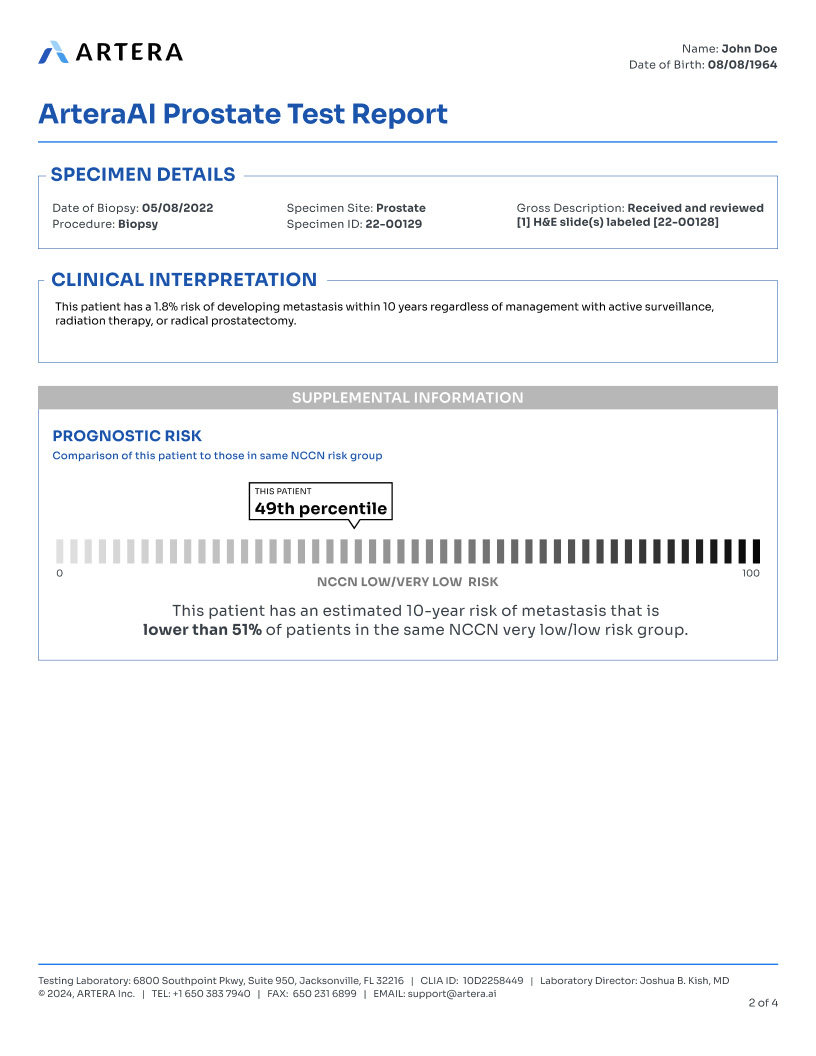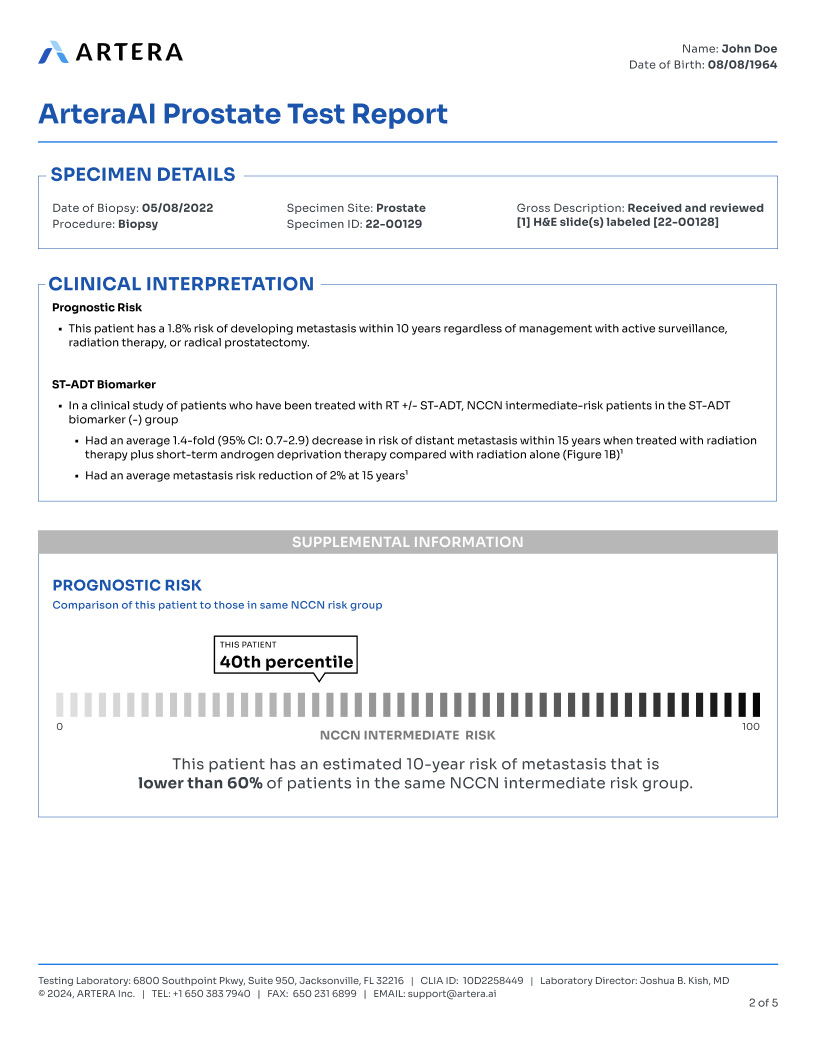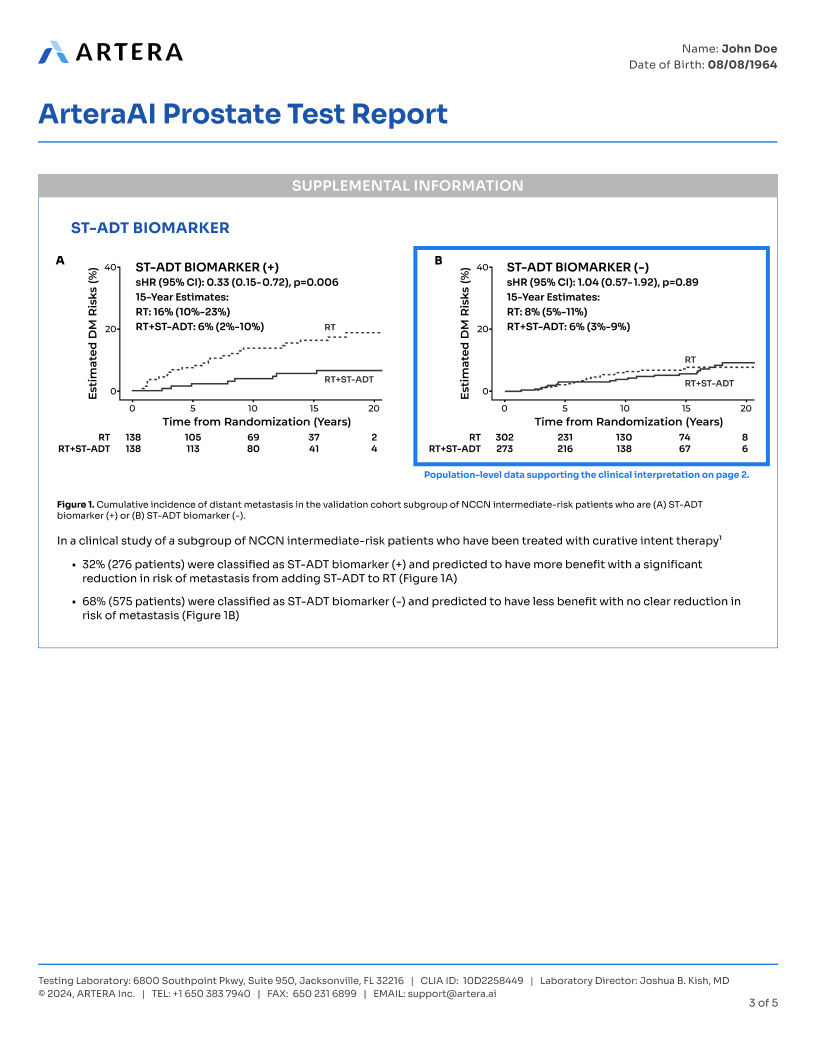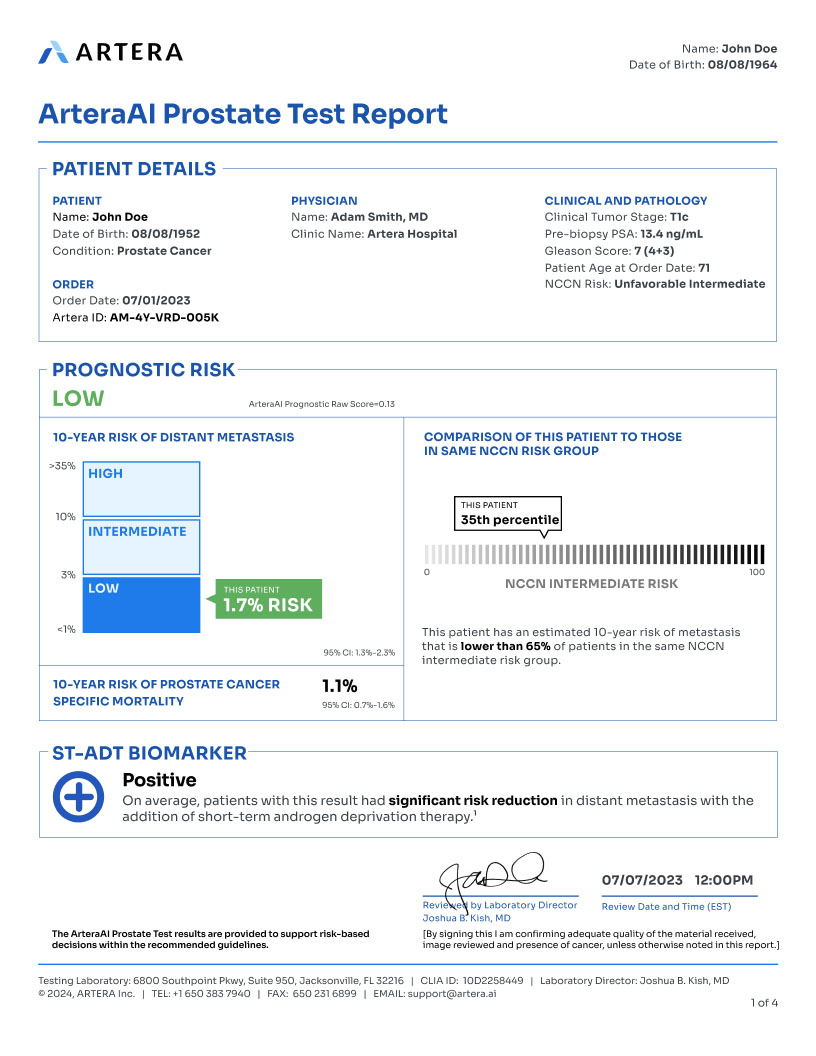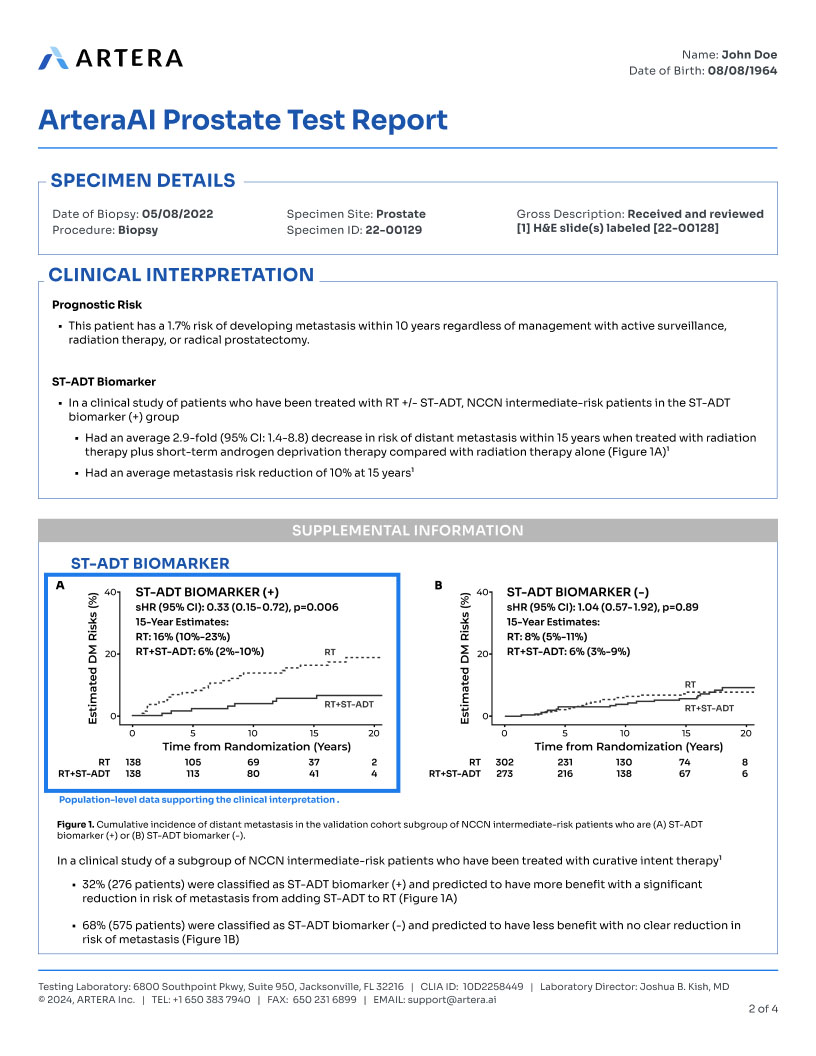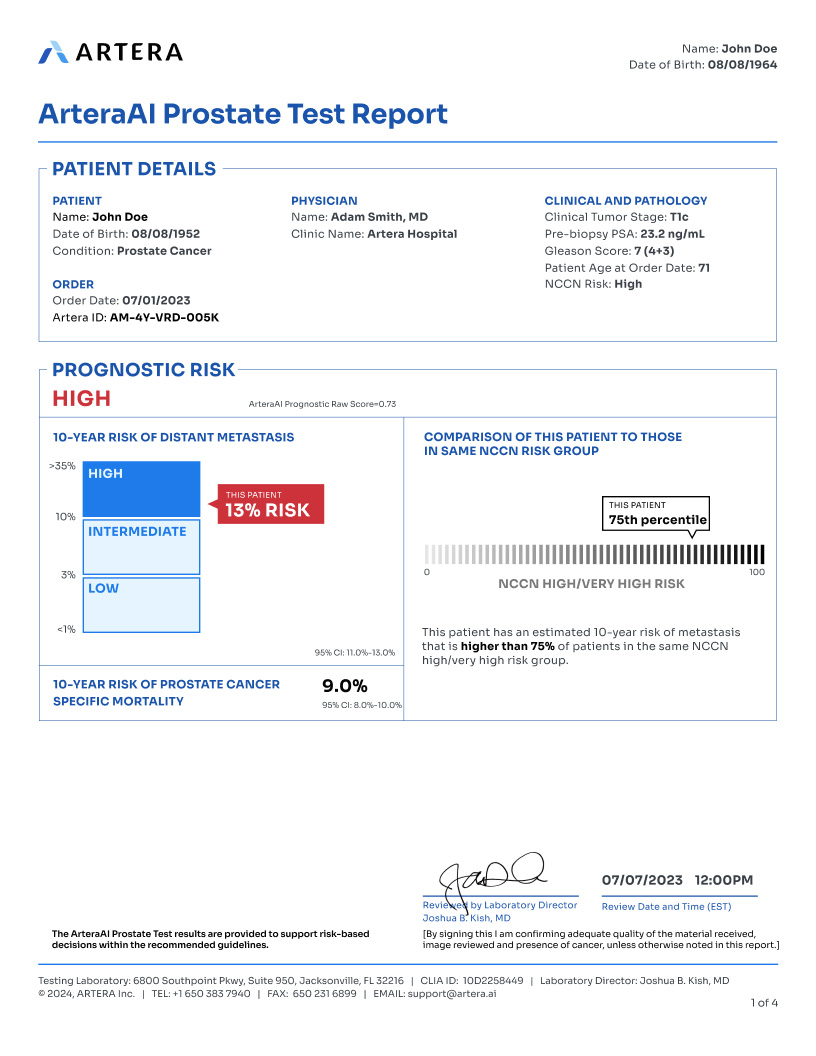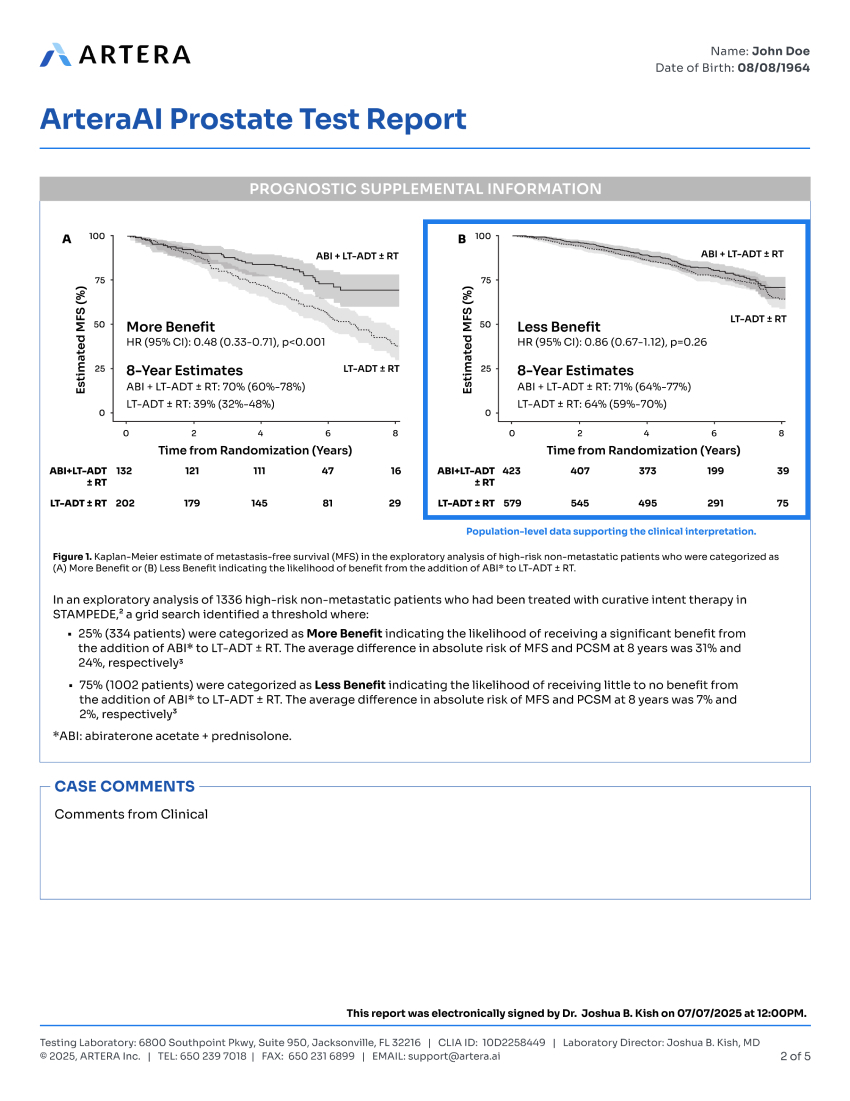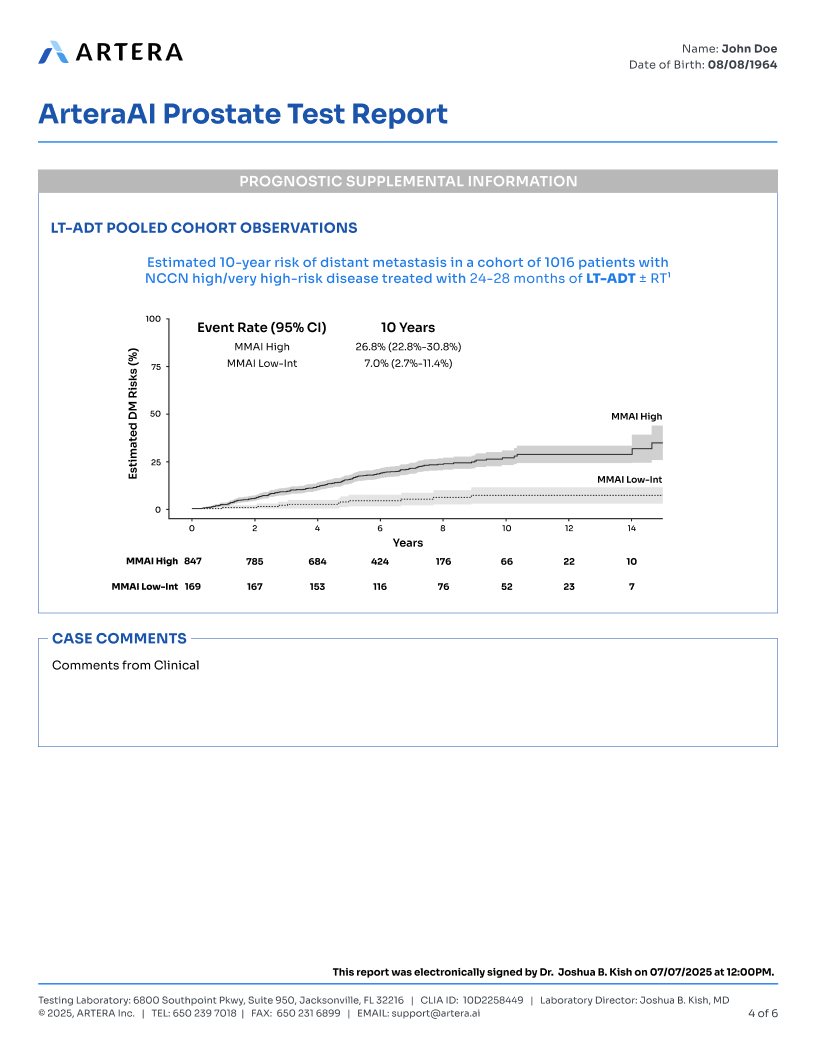Instructions: Select NCCN Risk Group to view the corresponding report.
Prognostic Risk
The ArteraAI prognostic risk group can explain how aggressive the patient’s prostate cancer is. The 10-year risk of distant metastasis is reported as a continuous variable with low-, intermediate-, and high-risk categories.
Active Surveillance Insights
For men with NCCN very low-, low-, and favorable intermediate-risk prostate cancer, comparing their risk of adverse pathology to that of other patients who were on active surveillance (AS) and underwent radical prostatectomy can help determine if AS is a suitable management option.
Additional Prognostic Endpoints
In addition to the 10-year risk of distant metastasis, 10-year risk of prostate cancer-specific mortality is also reported. This can help provide more information to support optimized
Comparison With National Comprehensive Cancer Network (NCCN) Risk Group
There is variability among patients within NCCN risk groups. A visualization is provided to show how the risk of metastasis, based on the ArteraAI risk score, compares to other patients with NCCN low/very low-risk disease.
Prognostic Risk
The ArteraAI prognostic risk group can explain how aggressive the patient’s prostate cancer is. The 10-year risk of distant metastasis is reported as a continuous variable with low-, intermediate-, and high-risk categories.
Active Surveillance Insights
For men with NCCN very low-, low-, and favorable intermediate-risk prostate cancer, comparing their risk of adverse pathology to that of other patients who were on active surveillance (AS) and underwent radical prostatectomy can help determine if AS is a suitable management option.
Additional Prognostic Endpoint
In addition to the 10-year risk of distant metastasis, 10-year risk of prostate cancer-specific mortality is also reported. This can help provide more information to support optimized decision-making.
Short-Term Androgen Deprivation Therapy (ST-ADT) Biomarker
For men with NCCN intermediate risk disease, an ST-ADT predictive biomarker result is provided. A “positive” result indicates the patient will likely benefit from ST-ADT added to radiation therapy. A “negative” result indicates the patient will likely not benefit from adding ST-ADT to radiation therapy. In a model validation study, 68% (575 patients) were classified as ST-ADT (-), indicating they could avoid treatment with ST-ADT. Only 32% (276 patients) were classified as ST-ADT (+) and predicted to derive benefit from adding ST-ADT to radiation therapy.
Clinical Interpretation
To help aid shared decision-making, a more detailed interpretation of the prognostic and predictive biomarker results is also provided.
Comparison With National Comprehensive Cancer Network (NCCN) Risk Group
There is variability among patients within NCCN risk groups. A visualization is provided to show how the risk of metastasis, based on the ArteraAI risk score, compares to other patients with NCCN intermediate-risk disease.
This graphic and text are dyanmic (same as current test report)
Data Supporting ST-ADT Interpretation
In a clinical study, intermediate-risk patients who were ST-ADT biomarker (+) had significantly reduced risk of metastasis at 15 years when adding ST-ADT to radiation therapy; patients who were ST-ADT biomarker (-) had little to no reduction in risk of metastasis when adding ST-ADT to radiation therapy. The accompanying Kaplan-Meier (K-M) curves show risk of distant metastasis over time. The K-M curve highlighted by the blue box represents the clinical study data supporting the clinical interpretation on page 2 of the report.
Prognostic Risk
The ArteraAI prognostic risk group can explain how aggressive the patient's prostate cancer is. The 10-year risk of distant metastasis is reported as a continuous variable with low-, intermediate-, and high-risk categories.
Comparison With National Comprehensive Cancer Network (NCCN) Risk Group
There is variability among patients within NCCN risk groups. A visualization is provided to show how the risk of metastasis, based on the ArteraAI risk score, compares to other patients with NCCN intermediate-risk disease.
Additional Prognostic Endpoint
In addition to the 10-year risk of distant metastasis, 10-year risk of prostate cancer-specific mortality is also reported. This can help provide more information to support optimized decision-making.
Short-Term Androgen Deprivation Therapy (ST-ADT) Biomarker
For men with NCCN intermediate risk disease, an ST-ADT predictive biomarker result is provided. A “positive” result indicates the patient will likely benefit from ST-ADT added to radiation therapy. A “negative” result indicates the patient will likely not benefit from adding ST-ADT to radiation therapy. In a model validation study, 68% (575 patients) were classified as ST-ADT (–), indicating they could avoid treatment with ST-ADT. Only 32% (276 patients) were classified as ST-ADT (+) and predicted to derive benefit from adding ST-ADT to radiation therapy.
Clinical Interpretation
To help aid shared decision-making, a more detailed interpretation of the prognostic and predictive biomarker results is also provided.
Data Supporting ST-ADT Interpretation
In a clinical study, intermediate-risk patients who were ST-ADT biomarker (+) had significantly reduced risk of metastasis at 15 years when adding ST-ADT to radiation therapy; patients who were ST-ADT biomarker (-) had little to no reduction in risk of metastasis when adding ST-ADT to radiation therapy. The accompanying Kaplan-Meier (K-M) curves show risk of distant metastasis over time. The K-M curve highlighted by the blue box represents the clinical study data supporting the clinical interpretation on page 2 of the report.
Prognostic Risk
The ArteraAI prognostic risk group can explain how aggressive the patient's prostate cancer is. The 10-year risk of distant metastasis is reported as a continuous variable with low-, intermediate-, and high-risk categories.
Comparison With STAMPEDE Patient Cohorts
There is variability among the patients within the STAMPEDE high-risk patient cohorts. This visualization is provided to show where the patient's MMAI risk score compares to lymph node-negative and lymph node-positive patients in the STAMPEDE trial.
Additional Prognostic Endpoint
In addition to the 10-year risk of distant metastasis, 10-year risk of prostate cancer-specific mortality is also reported. This can help provide more information to support optimized decision-making.
High Risk Insight - Adjunctive Abiraterone Therapy Benefit
For men with NCCN high- and very high-risk disease, a therapeutic signal for abiraterone adjunctive therapy is provided. Based on a prognostic score cutoff, patients above the cutoff are more likely to benefit from abiraterone added to LT-ADT +/- radiation therapy, whereas patients below the cutoff are less likely to benefit. In an analysis of 1335 high-risk non-metastatic patients, 25% (334) of patients were found to likely benefit from abiraterone adjunctive therapy and 75% (1001) of patients were found to not likely to benefit from abiraterone adjunctive therapy.
Data Supporting High Risk Insight Interpretation
In a clinical study, NCCN high- and very-high risk patients who were above the prognostic score cutoff had a significantly different rate of metastasis-free survival (MFS) rate when adding abiraterone therapy to LT-ADT to radiation therapy; patients who were below the prognostic score cutoff had little to no difference in the rate of MFS. The accompanying Kaplan-Meier (K-M) curve shows metastasis-free survival over time. The K-M curve highlighted by the blue box represents the clinical study data supporting the clinical interpretation on page 1 of the report.
Abiraterone Therapy Interaction Plot
This visualization shows an interaction plot, comparing how the different treatment arms of the STAMPEDE cohort fared. As the MMAI score increases, there is a divergence between the treatment arms with regards to MFS. Various MMAI cutpoints, such as the one between Low and Intermediate, Intermediated and High, and Abiraterone Benefit, are shown for reference to help guide shared decision making
LT-ADT Pooled Cohort Analysis
This is a pooled cohort analysis of the estimated 10-year risk of distant metastasis (DM) of 1016 patients with NCCN high- and very-high disease treated with 24-28 months of LT-ADT +/- radiation therapy. Patients with an MMAI High score had a 10-year risk of DM of 26.8%, whereas patients with an MMAI Low or Intermediate score had a 10-year risk of DM of 7.0%.

